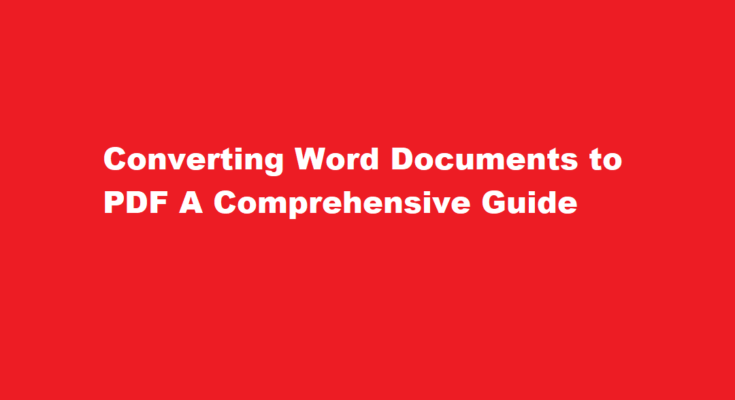In the modern digital age, the ability to convert Word documents to PDF format has become an essential skill for professionals, students, and anyone dealing with electronic documents. PDF (Portable Document Format) files are widely used due to their consistent appearance across different devices and platforms, making them an ideal choice for sharing and archiving documents. In this guide, we’ll explore the steps to convert Word documents to PDF while highlighting the benefits of this conversion.
Choosing the Right Conversion Method
There are various methods available to convert Word documents to PDF, catering to different user preferences and technological resources.
- Using Built-in Tools Most recent versions of Microsoft Word include a built-in “Save As” feature that allows direct conversion to PDF. Simply open the Word document, go to the “File” menu, select “Save As,” choose the PDF format, and click “Save.”
- Online Converters There are numerous online platforms that offer free and easy-to-use Word to PDF conversion. Websites like Smallpdf, PDF2Go, and Adobe Acrobat Online allow you to upload a Word file and receive the converted PDF in seconds.
- Desktop Software Software applications like Adobe Acrobat Pro provide advanced options for converting and editing PDFs. While these often come with a cost, they offer a range of functionalities beyond simple conversion.
Ensuring Document Formatting
Before converting, it’s crucial to ensure that your Word document is correctly formatted to prevent any unexpected layout issues in the PDF.
- Layout Consistency Check that fonts, images, and other elements appear as intended. PDFs are designed to maintain consistency, but it’s best to review your document in Print Layout mode before converting.
- Hyperlinks and Bookmarks If your Word document contains hyperlinks or bookmarks, make sure they are functional in the PDF. Most conversion methods preserve hyperlinks, but it’s wise to verify this during the conversion process.
- Page Breaks and Margins Adjust page breaks and margins if necessary. PDFs may not always retain the same automatic page breaks, so manual adjustments might be needed.
Converting the Document
The process of converting a Word document to PDF varies depending on the method you’ve chosen.
- Using Built-in Tools As mentioned earlier, the built-in “Save As” option in Microsoft Word is straightforward. It retains fonts, images, and basic formatting, making it suitable for simple documents.
- Online Converters When using an online converter, upload your Word document, and the platform will guide you through the conversion process. Once complete, download the PDF file to your device.
- Desktop Software In applications like Adobe Acrobat Pro, open the Word document, select the “Create PDF” option, and customize settings as needed. This method provides more control over the conversion process and is especially useful for complex documents.
Reviewing the Converted PDF
After conversion, it’s essential to review the PDF to ensure that the document appears as expected.
- Layout Check Open the PDF and verify that fonts, images, and other elements are in their proper places. Pay close attention to any irregularities that may have occurred during the conversion.
- Hyperlinks and Interactive Elements If your Word document contains hyperlinks or interactive elements, test them in the PDF to confirm that they are functioning correctly.
- Text Recognition (OCR) If your Word document includes scanned images or non-selectable text, consider using Optical Character Recognition (OCR) tools to make the text searchable and selectable in the PDF.
FREQUENTLY ASKED QUESTIONS
Does formatting change from Word to PDF?
Formatting Issues – The layout of the PDF is different from the original Word doc. For example, the text has been rearranged, the margins are a different size or the pagination is off.
Can Google Docs save as PDF?
On your computer, open a Google Doc. At the top, click File. Print. At the left, next to “Destination,” select Save as PDF.
In conclusion, the ability to convert Word documents to PDF is a valuable skill that offers numerous benefits, such as ensuring consistent document appearance across platforms and facilitating easy sharing and archiving. By selecting the appropriate conversion method, preparing your document correctly, and reviewing the final PDF, you can achieve seamless and professional results. Whether you’re a student submitting assignments, a professional sharing reports, or an individual archiving important documents, mastering the art of Word to PDF conversion is a valuable asset in the digital realm.
Read More : Securing Your Privacy A Guide to Locking Private Chats



